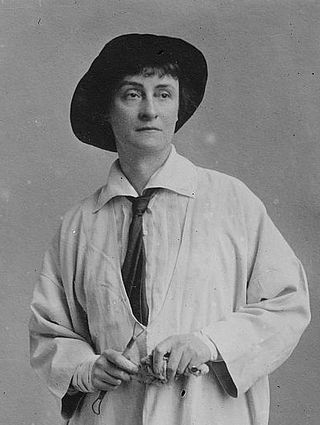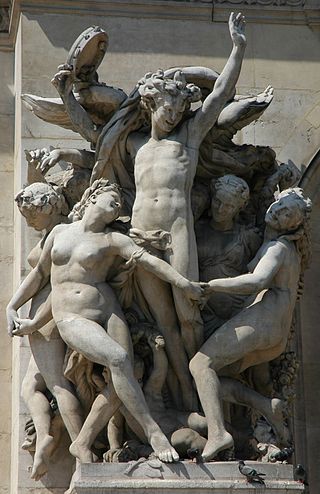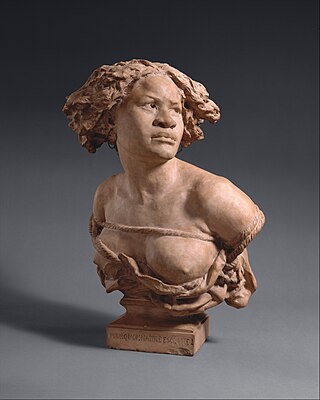
Edgar Degas was a French Impressionist artist famous for his pastel drawings and oil paintings.

Jean-Baptiste Carpeaux was a French sculptor and painter during the Second Empire under Napoleon III.

African art describes the modern and historical paintings, sculptures, installations, and other visual culture from native or indigenous Africans and the African continent. The definition may also include the art of the African diasporas, such as: African-American, Caribbean or art in South American societies inspired by African traditions. Despite this diversity, there are unifying artistic themes present when considering the totality of the visual culture from the continent of Africa.

The Jardin du Luxembourg, known in English as the Luxembourg Garden, colloquially referred to as the Jardin du Sénat, is located in the 6th arrondissement of Paris, France. The creation of the garden began in 1612 when Marie de' Medici, the widow of King Henry IV, constructed the Luxembourg Palace as her new residence. The garden today is owned by the French Senate, which meets in the Palace. It covers 23 hectares and is known for its lawns, tree-lined promenades, tennis courts, flowerbeds, model sailboats on its octagonal Grand Bassin, as well as picturesque Medici Fountain, built in 1620. The name Luxembourg comes from the Latin Mons Lucotitius, the name of the hill where the garden is located.

The Thinker is a bronze sculpture by Auguste Rodin, situated atop a stone pedestal. The work depicts a nude male figure of heroic size sitting on a rock. He is seen leaning over, his right elbow placed on his left thigh, holding the weight of his chin on the back of his right hand. The pose is one of deep thought and contemplation, and the statue is often used as an image to represent philosophy.
Events from the year 1868 in art.

Aimé-Jules Dalou was a 19th-century French sculptor, admired for his perceptiveness, execution, and unpretentious realism.

Janet Scudder, born Netta Deweze Frazee Scudder, was an American sculptor and painter from Terre Haute, Indiana, who is best known for her memorial sculptures, bas-relief portraiture, and portrait medallions, as well as her garden sculptures and fountains. Her first major commission was the design for the seal of the New York Bar Association around 1896. Scudder's Frog Fountain (1901) led to the series of sculptures and fountains for which she is best known. Later commissions included a Congressional Gold Medal honoring Domício da Gama and a commemorative medal for Indiana's centennial in 1916. Scudder also displayed her work at numerous national and international exhibitions in the United States and in Europe from the late 1890s to the late 1930s. Scudder's autobiography, Modeling My Life, was published in 1925.
Barbara Chase-Riboud is an American visual artist and sculptor, bestselling novelist, and award-winning poet.

Mathurin Moreau was a French sculptor in the academic style.

The Fontaine de l'Observatoire is a monumental fountain located in the Jardin Marco Polo, south of the Jardin du Luxembourg in the 6th arrondissement of Paris, with sculpture by Jean-Baptiste Carpeaux. It was dedicated in 1874. It is also known as the Fontaine des Quatre-Parties-du-Monde, for the four parts of the world embodied by its female figures, or simply the Fontaine Carpeaux.
E Pluribus Unum is a public artwork proposed by American artist Fred Wilson to be located along the Indianapolis Cultural Trail at the northeast corner of Delaware and Washington streets, near the City-County Building in downtown Indianapolis, Indiana, United States.
La Hermana del Hombre Bóveda is a public artwork by Spanish artist Pablo Serrano, located at Newfields, the museum campus that houses the Indianapolis Museum of Art near downtown Indianapolis, Indiana. The artwork is an abstract bronze piece which tops a granite fountain.

La Danse is an 1868 sculpture by the French artist Jean-Baptiste Carpeaux. It was one of four sculptural groups made from Echaillon marble that decorate the façade of the Opera Garnier in Paris, two to either side of the entrance at ground level. The work was installed in 1869, and widely criticised as obscene. It was attacked in August 1869 when an anonymous vandal threw black ink over it. The scandal subsided after the outbreak of the Franco-Prussian War in 1870, and the original statue remained on the façade at the opera until it was transferred to the Louvre Museum in 1964 and replaced by a copy. The original was moved to the Musée d'Orsay in 1986.
Enid Bell Palanchian, known professionally as Enid Bell in her early career and later on as Enid Bell Palanchian, was an American sculptor, illustrator and teacher born in London, England.

Ugolino and His Sons is a marble sculpture of Ugolino made by Jean-Baptiste Carpeaux in Paris during the 1860s. It depicts the story of Ugolino from Dante's Inferno in which the 13th century count is imprisoned and starving with his children. The work, known for its expressive detail, launched Carpeaux's career.

French sculpture has been an original and influential component of world art since the Middle Ages. The first known French sculptures date to the Upper Paleolithic age. French sculpture originally copied ancient Roman models, then found its own original form in the decoration of Gothic architecture. French sculptors produced important works of Baroque sculpture for the decoration of the Palace of Versailles. In the 19th century, the sculptors Auguste Rodin and Edgar Degas created a more personal and non-realistic style, which led the way to modernism in the 20th century, and the sculpture of Pablo Picasso, Georges Braque, Marcel Duchamp and Jean Arp.

Why Born Enslaved? or Why Born a Slave? is a life-sized bust by the French sculptor Jean-Baptiste Carpeaux depicting a bound woman of African descent. Carpeaux executed versions of the sculpture in plaster, marble, terracotta, and bronze. It is represented in a number of museums, including the Ny Carlsberg Glyptotek in Copenhagen and the Metropolitan Museum of Art in New York City.

Hettie Anderson was an African-American art model and muse who posed for American sculptors and painters including Daniel Chester French, Augustus Saint-Gaudens, John La Farge, Anders Zorn, Bela Pratt, Adolph Alexander Weinman, and Evelyn Beatrice Longman. Among Anderson's high-profile likenesses are the winged Victory figure on the Sherman Memorial at Grand Army Plaza in Manhattan, New York City and $20 gold coins known as the Saint-Gaudens double eagle. Theodore Roosevelt deemed Victory "one of the finest figures of its kind." Saint-Gaudens described Anderson as "certainly the handsomest model I have ever seen of either sex" and considered her "Goddess-like."

The Negress head clock is a type of French Empire mantel clock depicting the head of a black woman flanked by sculptured putti. It is considered among the eccentricities of French horology and had drawn attention during the late eighteenth century. Five examples are noted in prominent collections.















